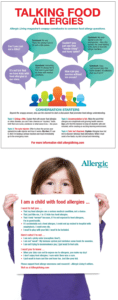
Back-to-school season is a big deal in every student’s life. But when a child has food allergies, a parent must be highly organized and communicate well to ensure that the school is on top of anaphylaxis prevention measures and safety protocols. Also essential is that your student gets to be a full participant in school life, including class activities or outings. To help guide you through achieving these goals, Allergic Living provides:
8 Tools for School with Food Allergies
1. The Emergency Care Plan for Anaphylaxis.
If you haven’t got an Emergency Care Plan for Allergies and Anaphylaxis, this is a vital school tool. So, do make it a priority. A doctor will fill out and sign this important tool that details your child’s allergies, sets out the symptoms of anaphylaxis, and reminds school staff members of when to give epinephrine and the emergency steps to follow promptly in case of your child has an allergic reaction.
Here are:
American Academy of Pediatrics’ Allergy & Anaphylaxis Emergency Plan
AAAAI’s Anaphylaxis Emergency Action Plan
FARE’s Food Allergy & Anaphylaxis Emergency Care Plan
In Canada, Food Allergy Canada’s: Anaphylaxis Emergency Plan
2. Your Allergic Student’s Rights to Accommodations.
In U.S. schools, all students with a medical condition should have an IHCP or Individual Health Care Plan. Beyond that document is the individualized 504 Plan, which includes measures to ensure that students with “disabilities” have equal access to education in public schools. Many food-allergic students have 504 Plans. Allergic Living recommends seeking one for strong clarity on accommodations – from the class to the lunchroom to the bus to the field trip. Read about how to get one here.
In Canada: See provinces’ laws and policies on food allergy accommodations here.
3. CDC’s Food Allergy Guidelines for Schools plus SAMPRO.
They are officially called the Voluntary Guidelines for Managing Food Allergies in Schools and Early Care and Education Programs. These guidelines may be voluntary, but they carry clout as official documentation. The CDC’s authors cover everything from seating at lunch to field trips, bus driver training and avoiding food as classroom rewards. Make sure your child’s principal is aware of the guidelines. Here is the CDC’s downloadable document. (Particularly helpful are the charts on pages 43-46.)
A related essential resource is the School-Based Allergies and Asthma Management Program (SAMPRO), which is part of the federal Public Health Service Act. It includes helpful asthma and anaphylaxis plans, checklists and a stock epinephrine tool kit.
4. Eating at School, Plus Ages and Stages.
To help guide you on possible accommodations on food, we recommend two articles from food allergy and schools expert Gina Clowes. They make excellent tools to share with the school:
– Food Allergies and the Cafeteria: Safe, Inclusive Options.
– In the Classroom, Exclude the Treats, Not the Child.
Specific accommodations that a food-allergic student needs will evolve as they mature and advance through school. Allergic Living created a thorough list of issues and approaches at the elementary, middle school and high school levels. See: Food Allergies: Guide to Big Issues at All School Levels.
5. Meeting with The School.
Nervous about the meeting with the school to discuss your child’s allergy accommodations? Gina Clowes has 10 steps to success to negotiate food allergy accommodations. The expert lays out the research and prep work to undertake ahead of that meeting. “Many parents begin calling and talking with the school prematurely, which can in turn sabotage their own efforts,” notes Clowes. Get her 10 steps for the school meeting here.
Also, parenting contributor Megan Lavin shares her personal experiences of meeting with schools to get food allergy accommodations for her sons. View her video.
 6. Allergic Living’s Free Educational Posters and Resources.
6. Allergic Living’s Free Educational Posters and Resources.
Our popular posters are great factual and visual reminders to share with your child’s school.
Six That Save Lives
I Am a Child with Food Allergies, and more.
7. Kids and Their Auto-Injectors at School.
Be sure to have a plan with school administrators and your student about where epinephrine auto-injectors will be kept. Given the need for the quick-acting medicine in an anaphylactic emergency, it’s wise to have the injectors with the student (or with a teacher with young children).
An issue that arises is auto-injectors being locked in a school nurse’s office. In an excellent article, Lianne Mandelbaum writes about that issue and how to work with the school to avoid this. As well, do remind teens that the locker is NOT an appropriate place to keep auto-injectors. That’s behind a lock and the student may also be at a distance.
Related Ask the Allergists Q&As:
How Do I Know Exactly When to Use the Auto-Injector?
When is a Child Old Enough to Self-Inject?
How to Effectively Clean Allergenic Foods Off a School Desk
An Allergic Child and Safety on the School Bus
8. Food Allergy Bullying: How to Spot and Prevent
Unfortunately, about one-third of food-allergic children are bullied because of their food allergy. You want to be aware of the signs of bullying. In this article, two leading experts address how to spot if your child is the target of food allergy bullying, how to help your child or teen, and how to talk to school staff and prevention approaches.
Plus, a great school tool is our related downloadable handout: Taking on Bullying.
Related Reading:
Food Allergies at School: Plans and Laws to Keep Kids Safely Included
Guide to the Food-Allergic Student’s Safe Transition to Middle or High School
Field Trips & Food Allergies: Staying Safe Beyond the Classroom
Key Nonprofit Resources:
FAACT: Back-to-School Headquarters
FARE course: Keeping Students Safe and Included
Kids with Food Allergies: 10 School Planning Tips
Beyond Celiac: Information for Schools






